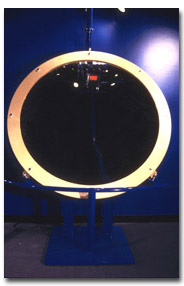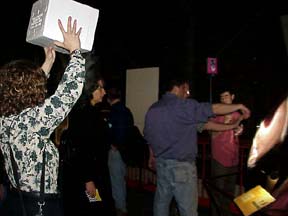
The red object you see reflected in this parabolic mirror is a heater. Place your hand on the image and you can feel the image made by the infrared radiation emitted by the heater.
Introduction
The Exploratorium exhibit Hot Spot features a
large parabolic mirror and a heater.
The mirror makes an image of the heater that you can see with your
eyes and feel with your hand. One day, Tom Humphrey overheard a
visitor from another museum say that if you replaced the heater with
a block of dry ice you would feel a cold spot at the location of the
image of the dry ice. Was the visitor right?
This being the Exploratorium, the visitor's hypothesis lead to a series of experiments.

Let's Do It!
Tom gathered two dozen staff members to conduct an experiments.
He described the set-up: A block of dry ice will be placed near a large parabolic mirror. Then we would feel the image with our hands to see whether we could feel a cold spot or not.
Tom had us all vote on our expectation of the result of the experiment.
We then conducted the experiment.

Some people said they could feel the cold spot,
others could not. I thought I could feel the cold spot.
It was obviously time to conduct a blind experiment.
A Blind Experiment
Several of us who thought we could feel the cold spot were placed so we could not see whether the block of ice was covered with a cardboard shield or not. Our hands were placed at the location of the image and we were asked to say whether we could feel the cold or not. There was no connection between when we felt the cold spot and when the dry ice block was imaged or covered.
It was a dramatic demonstration of the need for a blind experiment. I thought I was an impartial observer, and yet I was fooled by my own expectations.
Using Instruments
One day, several months later, some visitors from Massachusetts brought with them a very sensitive digital recording thermometer. They were looking for experiments to conduct at the Exploratorium. I lead them to the Hot Spot exhibit.
They measured the temperature at the image of the heater to be 120 °C.
I then grabbed the Styrofoam case and block of dry ice and continued the experiment.
They measured a cool spot at the location of the image of the block of dry ice, their probe was 0.2 °C colder when it was placed at the image location. We could repeat the experiment over and over.
So the answer was in: there is a measurable cold spot produced at the image of a block of dry ice, however the cold spot is hard to detect with a human hand.
What's Going On?
The heater reflects light which bounces off the mirror and creates an image.
The heater also gives off infrared radiation which follows the same rules of reflection as the light and is brought together at the position of the image. The heater is over a thousand degrees hotter than room temperature, its image is over 100 degrees celsius warmer than room temperature.
The block of ice is almost 100 degrees celsius cooler than room temperature. It gives off less thermal radiation than the room around it does. This lower level of thermal radiation is imaged by the mirror at the location of the visible light image of the block of dry ice. Less radiation arrives at this point, and so the air at that point is cooler, although only by a fraction of a degree.
|
Scientific Explorations by Paul Doherty |
|
26 April 2001 |